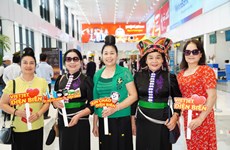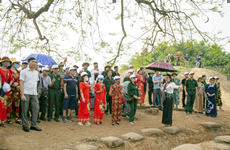Pu Luong a fantastic retreat for nature lovers

Hanoi (VNA) – Fresh air, cloud-draped mountain ranges, and stunning terraced rice fields come together to make Pu Luong Nature Reserve in the central province of Thanh Hoa’s Ba Thuoc and Quan Hoa districts look like art works.
Pu Luong makes an ideal destination for a short break, as it is surrounded by nature, though neighther too far from Hanoi nor too expensive. Travellers with a penchant for nature will be spoilt for choice while discovering this nature reserve.
Pu Luong is known as “gate to the sky”, where tourists can strike a pose while enjoying the breathtaking panoramic views of the Pu Luong Nature Reserve, with colourful forest flowers, native animals, and tranquil villages.
When local farmers flood the fields to prepare for a new crop, a spectacular sight emerges, with giant natural mirrors reflecting the blue sky. It is also magical to see the slopes and valleys of Pu Luong turn yellow during the ripe rice season.
 A check-in point in Pu Luong Nature Reserve (Photo: VietnamPlus)
A check-in point in Pu Luong Nature Reserve (Photo: VietnamPlus)Travellers can also enjoy the fantastic scenery of forests, fields and valleys from the top of Pu Luong, at 1,700-metres.
Kho Muong village, which sits in a pristine and rustic valley of the same name, is one of the most difficult villages to reach in the area, but is a must-visit destination for anyone who enjoys community tourism.
There are several paths to the village but just one road for cars. The road’s track is narrow with a steep drop on one side. The path is nearly 3km through the forest from the main road.
Looking down, Kho Muong is surrounded by vast green mountains and forests. There are stilt houses close to the foot of the mountain and paddy fields, where farmers plant rice and plough the land while others raise ducks.
Visitors must not miss Doi (bat) Cave, a mysterious destination reached through a precarious path covered by trees. The cave is made out of limestone, which was formed hundreds of millions of years ago. It is connected with an underground river system about 2.5km to the north. Doi Cave is home to at least four species of bats and houses rock formations that resemble humans, trees and animals.
Discovering the local cuisine and culture is a highlight of any trip to Pu Luong. There is nothing more delightful than food made from ingredients grown right in the area. Pu Luong is home to an array of vegetables, such as baby pumpkin leaf, green beans and bamboo shoots. For a real Pu Luong lunch or dinner, visitors should try the locally raised pork and grilled mountain snails dipped in fish sauce.
Around Pu Luong, there is a wide range of popular tourist sites such as Hoa Binh Lake and Lac village in Mai Chau district in Hoa Binh province, Cam Luong Holy Fish Stream, and Cuc Phuong National Park in Ninh Binh province.
| A number of community-based tours have been developed in Don hamlet, Thanh Lam commune, Ba Thuoc district. Pu Luong is a nature reserve established in 1999 with its area covering Ba Thuoc and Quan Hoa districts. It is considered as a valuable natural reserve for science research, socio-economic and ecotourism development. The tours offer visitors activities to discover local primeval forests, waterfalls, rivers and mountains. They can also participate in traditional festivals of the locality, visit traditional trade villages, enjoy local specialties, and experience the daily activities of locals, especially those from ethnic minority groups. Visitors can take one-day tours in Pu Luong, or two-day tours across three districts of Ba Thuoc, Quan Hoa, and Lang Chanh. There are also tours going cross Hoa Binh province to Ba Thuoc. Chairman of Ba Thuoc district People’s Committee Lo Van Thang said the development of community tourism is hoped to assist with poverty reduction, raise income, and improve the livelihood of local residents, thus contributing to bolstering the locality’s socio-economic development. Ba Thuoc is working to create a breakthrough in tourism development, and has set a goal to welcome 30,000 visitors by 2020, of which about one third are international tourists./. |













